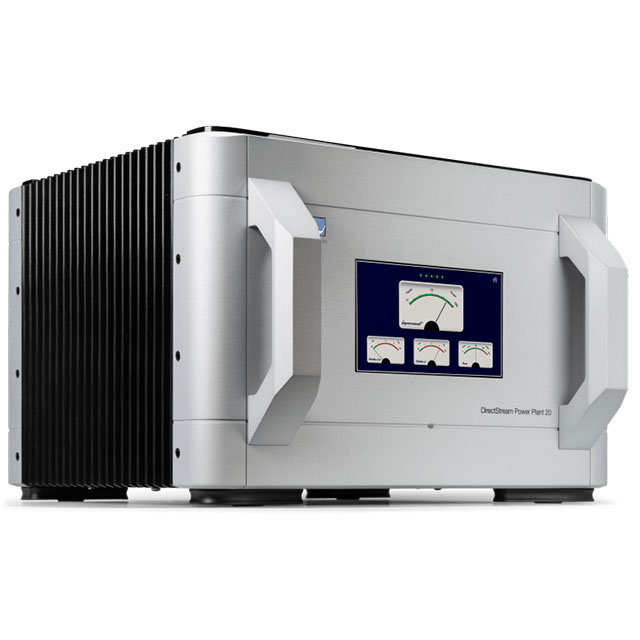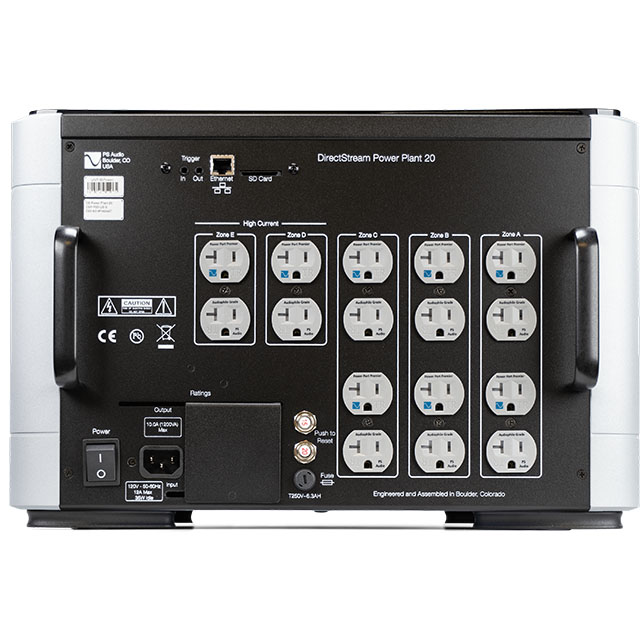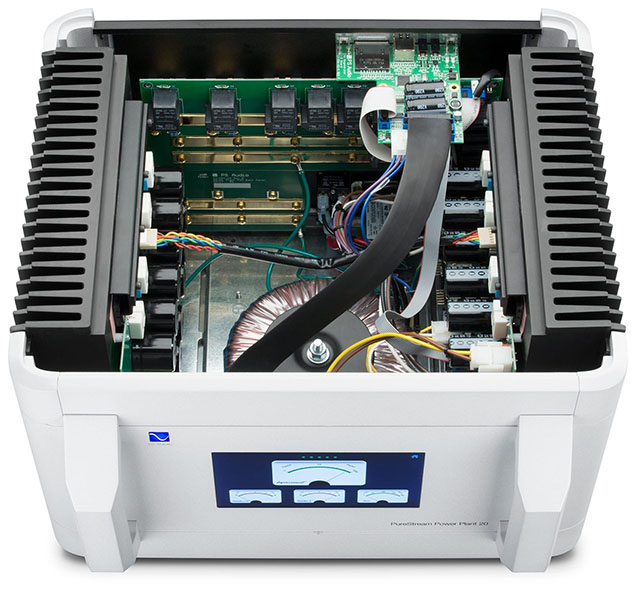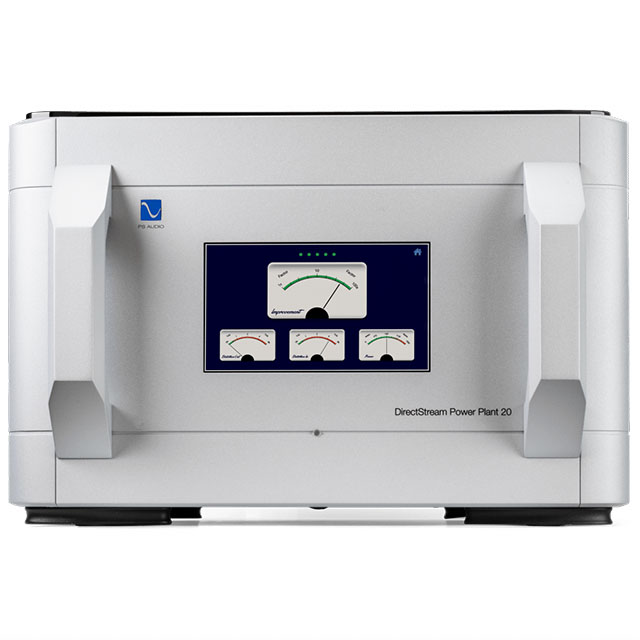PS Audio Power Plant P20 AC Regenerator by Moreno Mitchell

 PS Audio, A company that needs no introductions
PS Audio, A company that needs no introductions
The PS Audio Company has always intrigued me with its impressive and long-standing array of outstanding products. Since my first visit to the Rocky Mountain Audio Fest in 2008, I had my first encounter with the company while hanging out with my colleagues Clement Perry and Bill Wells. We paid a visit to the PS Audio exhibit, and my journey with PS Audio began at that point. I later accomplished extensive research on their company, which revealed how PS Audio started as a high-end manufacturer in 1974. Paul McGowan and Stan Warren were the founders, thus explaining the P (Paul) and S (Stan) in PS Audio. This company has much history that is well documented in the audio press that I need not reiterate. First, however, I need to point out that their level and history of quality have never wavered.
Since my introduction to the PS Audio brand, I have owned several outstanding products, including Power Cables, Power Ports, Direct Stream Memory Player, Stella Gain Cell DAC, etc. However, for this review, I will focus on the review sample P20 Power Regenerator. Before investing in a PS Audio Power Regenerator, I was blindly convinced that the only technology dealing with cleaning up dirty electrical power was accomplished by a power conditioner.
Throughout the years, I owned several power conditioners, from low-cost to ultra-high-cost products. However, I was never completely satisfied with how they interacted with my system components. Since power conditioners are essentially massive filtering devices, it wasn’t easy to find one that did not alter my system components’ sound. The PS Audio Power Regenerators take a different approach than what power conditioners accomplish. Without getting too technical, the PS Audio Power Regenerators clean the Alternating Current power rather than filter it. To explain this in a macro sense: AC power is taken from the wall and changed from alternating current (AC) to direct current (DC). Next, the existing current is cleaned up and then switched back to AC fed to one’s system components.
 Handling of the PS Audio Direct Stream P20 Power Regenerator (referred to as P20 throughout this review) is not intended to be a one-person operation due to the weight of the unit. It comes in at over 100 pounds when packed in a shipping box; 96 pounds total weight for the unit itself. However, PS Audio is world-class when it comes to packing equipment for transport; this was evident when the P20 arrived well packed in a very sturdy box with a pair of carrying handles. The handles made it relatively easy to handle the heavy beast into my listening room. Being an ex-power lifter, I found this task relatively easy. I marveled at the company’s thought into the packing design; they made it relatively easy to unbox the unit simply by turning two tabs on the box to open and then slide out the P20 without lifting the unit. All accessories were also secured in their foam compartments for transport. The P20 unit also has lifting handles on the front and back of the carton for easy maneuverability. The P20’s touchscreen display is large and easy to read; it encompasses four meters indicating the power being used by connected devices, the total harmonic distortion in the incoming waveform and outgoing waveforms, and the differences in the improvement factor. Immensely helpful when determining the bad from the healthy current. Aside from the quality of the current, the P20 will also protect your equipment against AC surges.
Handling of the PS Audio Direct Stream P20 Power Regenerator (referred to as P20 throughout this review) is not intended to be a one-person operation due to the weight of the unit. It comes in at over 100 pounds when packed in a shipping box; 96 pounds total weight for the unit itself. However, PS Audio is world-class when it comes to packing equipment for transport; this was evident when the P20 arrived well packed in a very sturdy box with a pair of carrying handles. The handles made it relatively easy to handle the heavy beast into my listening room. Being an ex-power lifter, I found this task relatively easy. I marveled at the company’s thought into the packing design; they made it relatively easy to unbox the unit simply by turning two tabs on the box to open and then slide out the P20 without lifting the unit. All accessories were also secured in their foam compartments for transport. The P20 unit also has lifting handles on the front and back of the carton for easy maneuverability. The P20’s touchscreen display is large and easy to read; it encompasses four meters indicating the power being used by connected devices, the total harmonic distortion in the incoming waveform and outgoing waveforms, and the differences in the improvement factor. Immensely helpful when determining the bad from the healthy current. Aside from the quality of the current, the P20 will also protect your equipment against AC surges.
Energy dissipation of 2040 joules is the industry standard for a high-capacity surge protector. A peak current surge of 180,000A is very impressive – the latter is where the P20 specs out! The P20 houses six heavy-duty metal oxide varistors (MOV) that provide exceptional levels of surge protection. These high-quality surge protection components are crucial at protecting expensive audio equipment from power surges, while on the other hand, not compromising or degrading the sound of one’s system.
Statement from the PS Audio Website:
“The DirectStream P20 Power Plant is our finest expression of the art of delivering protected, pure, regulated, distortion-free AC power. With peak power levels of 3600 watts, no equipment can tax the mighty P20. Finally, your most coveted components have the opportunity to unleash their full potential. DirectStream P20 regulates both long-term fluctuations and peak dynamics without deviation, ensuring a solid foundation from which to build a state-of-the-art system. Its low output impedance and unhindered AC delivery are equivalent to less than 50 feet of 12-gauge wire connected directly to your city power source without the connecting miles of wire, the many transformers, and the multiple neighbors weakening and contaminating your power.”
Connecting to the P20
 I began by connecting my pair of Behold BPA768 Power Amps to the four available high current hospital-grade outlets of the P20. Keep in mind that the Behold Audio BPA768 amplifiers house 16 DAC’s under each chassis, thus requiring the best power source available. In addition, these German-made amplifiers are very power-sensitive. I connected the BPA768 via the excellent Bela Sound Kuala AC Power Cords. I next watched as the power meter from the P20 display indicated an increase of power being generated. I took my time to allow the unit two weeks to properly break in before making any observations or assumptions of the sound quality. Before the two weeks of burn-in, I could not detect any sonic improvements. However, after the 2-weeks, I noticed a vast improvement in sound quality coming from my YG Acoustic Hailey loudspeakers. I would admit that I enjoyed the sound before the P20s arrival. With only a pair of the Behold BPA amps plugged into the P20, the sound became more solid and transparent. Since my front-end components are on the other side of the room (making it nearly impossible to connect to the P20), I decided to task the P20 creatively.
I began by connecting my pair of Behold BPA768 Power Amps to the four available high current hospital-grade outlets of the P20. Keep in mind that the Behold Audio BPA768 amplifiers house 16 DAC’s under each chassis, thus requiring the best power source available. In addition, these German-made amplifiers are very power-sensitive. I connected the BPA768 via the excellent Bela Sound Kuala AC Power Cords. I next watched as the power meter from the P20 display indicated an increase of power being generated. I took my time to allow the unit two weeks to properly break in before making any observations or assumptions of the sound quality. Before the two weeks of burn-in, I could not detect any sonic improvements. However, after the 2-weeks, I noticed a vast improvement in sound quality coming from my YG Acoustic Hailey loudspeakers. I would admit that I enjoyed the sound before the P20s arrival. With only a pair of the Behold BPA amps plugged into the P20, the sound became more solid and transparent. Since my front-end components are on the other side of the room (making it nearly impossible to connect to the P20), I decided to task the P20 creatively.
I operate a six stack of REL G1 MKII subwoofers that incorporate 600-watt amplifiers; while being creative, I decided to connect all six subs to the P20 to see how it would handle the additional power requirements. Note: The P20 was connected to a regular 120 AC outlet. I bring this up since the unit’s specification can deliver only 1200 watts of pure power when connected to a 120V AC outlet. The P20 is ultimately capable of outputting 2000 watts only when connected to a 220V AC outlet. The P20 offers dual inlets for either 120 or 220V connections. Since I do not have a 220 AC outlet, I was limited to using only 2/3 of the P20’s maximum capabilities.
Continuing with loading up the P20 the best I could with the addition of the six stack subs, the unit performed marvelously, playing music at a moderate level. The power meters were tasked at around 80% but did not overload. However, all in all, the P20 performed without a hitch; no sign of degrading sound quality. My system never sounded better, and it sounded far more musically impactful with less harshness and strain. Since AC power is the blood lifeline of any system, it is nearly impossible to point out where the most significant improvements are coming from. I live in a relatively new community; electric power has never been an issue as we very seldom experience power surges or brownouts. Considering the miles and miles of electric line it takes to serve a community, I believe there must be some loss of quality in the AC source. I am not an electrical engineer, so my claims are based solely on my thoughts and assumptions at best. I believe contamination and noise are coming into the AC lines, resulting in the potential degradation of my audio system. However, the PS Audio P20 addition gives my audio system the chance always to perform optimally.
Listening with the P20
 Digital Playback. After one month’s burn-in time, I felt I was ready to accomplish some critical listening with the P20. Once the essential listening began, I noticed immediately that the background was blacker. This aspect was a surprise to me because I felt this was never a problem in the past. I attribute this improvement to less AC noise in the system. I achieved a better sense of increased frequency response in all frequencies, including bass, mid-range, and highs. The bass content of the entire recording was tighter and better distinguished throughout. Listening to one of my favorite recordings, Herbie Hancock’s “The Joni Letters” gave me a sense of rejuvenated joy; with Norah Jones singing on track one, Court and Spark, always is a treat, however, with the absence of the noise factor, this song took on a different meaning of increased enjoyment and excitement. The entire band and Herbie’s perfectionist master handling of the keys on the keyboard were a sound of beauty. I have not heard or realized how beautiful a track this was until the P20 predominately eliminated the noise. The richness of Norah Jones’s recorded voice on this excellent album is simply exceptional. No wonder this album won a Grammy. However, to realize just how much more I was missing from this album, it took the addition of the P20 to bring it all out, thus turning up the quiet.
Digital Playback. After one month’s burn-in time, I felt I was ready to accomplish some critical listening with the P20. Once the essential listening began, I noticed immediately that the background was blacker. This aspect was a surprise to me because I felt this was never a problem in the past. I attribute this improvement to less AC noise in the system. I achieved a better sense of increased frequency response in all frequencies, including bass, mid-range, and highs. The bass content of the entire recording was tighter and better distinguished throughout. Listening to one of my favorite recordings, Herbie Hancock’s “The Joni Letters” gave me a sense of rejuvenated joy; with Norah Jones singing on track one, Court and Spark, always is a treat, however, with the absence of the noise factor, this song took on a different meaning of increased enjoyment and excitement. The entire band and Herbie’s perfectionist master handling of the keys on the keyboard were a sound of beauty. I have not heard or realized how beautiful a track this was until the P20 predominately eliminated the noise. The richness of Norah Jones’s recorded voice on this excellent album is simply exceptional. No wonder this album won a Grammy. However, to realize just how much more I was missing from this album, it took the addition of the P20 to bring it all out, thus turning up the quiet.
Analog Playback I switched to analog through my Project RPM 10 turntable to get a taste of vinyl listening through the P20. The results were also astonishing. As with digital, the lowering of the noise floor brings enormous benefits. However, with analog, the results are a bit more natural in sound quality. In my opinion, analog presentation emulates closer to listening to live music. The lower the noise floor, the closer I felt to the venue. Over the years, digital playback has made huge strides and has closed the analog gap tremendously. But always keep in mind whenever you read a digital advertisement’s claim, “it sounds closer to analog.” That tells you analog is still king of the hill. The addition of the P20 and its noise reduction capability reminded me just how true that statement is.
I switched to analog through my Project RPM 10 turntable to get a taste of vinyl listening through the P20. The results were also astonishing. As with digital, the lowering of the noise floor brings enormous benefits. However, with analog, the results are a bit more natural in sound quality. In my opinion, analog presentation emulates closer to listening to live music. The lower the noise floor, the closer I felt to the venue. Over the years, digital playback has made huge strides and has closed the analog gap tremendously. But always keep in mind whenever you read a digital advertisement’s claim, “it sounds closer to analog.” That tells you analog is still king of the hill. The addition of the P20 and its noise reduction capability reminded me just how true that statement is.
Conclusion and final thoughts
The opportunity to spend time with the PS Audio P20 has been an absolute joy for me, and to say the least special. PS Audio has a special place in my audio heart as I have admired the company for its dedication to sound improvement and quality. The P20 is a bit pricey; however, other models of the Power Regenerator (P15 and P12) are available at lesser pricing that will give you the same value as their big brother. PS Audio continues to be the front runner in the area of audio power products. They seem to know what we audio perfectionists desire. Paul McGowan is a music lover who knows what the true audiophile/music lover wants. The evolution of the P20 backs my statement. This baby is a keeper…. Thanks, PS Audio.

Moreno Mitchell
Description/Specifications
Price: $9,999
Unit Choices: Silver or Black
Unit Dimensions: 17 X 14 X 11
Unit Weight: 96 lbs.
2000 VA output (220V)
1200 VA output (120V)
Outlets: 16 Grounded
Maximum Peak Level: 3600 VA
Color Touchscreen
Multi-wave Pure Sine Wave
Integrated Oscilloscope
THD Meter
Power Meter
Under Voltage Limiter
Over Voltage Limiter
Peak Current Surge: 180,000A
Standby Power Consumption 35 Watts
Efficiency @1500 VA >85% >85%
Input Frequency: 45 – 65 Hz
Website: www.psaudio.com
Moreno’s Associated Equipment:
Amplification: Behold BPA768 Amps
PreAmp: Behold APU768
Digital: Memory Player64 Transport,
Auralic Aries Streaming Transport
Roon Nucleus
Analog: Project RPM10 Turntable
Speakers: YG Acoustics Hailey 2.2
REL 6 stack G1 MKII Subwoofers
Stereo Times Masthead
Publisher/Founder
Clement Perry
Editor
Dave Thomas
Senior Editors
Frank Alles, Mike Girardi, Russell Lichter, Terry London, Moreno Mitchell, Paul Szabady, Bill Wells, Mike Wright, and Stephen Yan,
Current Contributors
David Abramson, Tim Barrall, Dave Allison, Ron Cook, Lewis Dardick, John Hoffman, Dan Secula, Don Shaulis, Greg Simmons, Eric Teh, Greg Voth, Richard Willie, Ed Van Winkle, Rob Dockery, Richard Doran, and Daveed Turek
Site Management Clement Perry
Ad Designer: Martin Perry











Be the first to comment on: PS Audio Power Plant P20 AC Regenerator by Moreno Mitchell